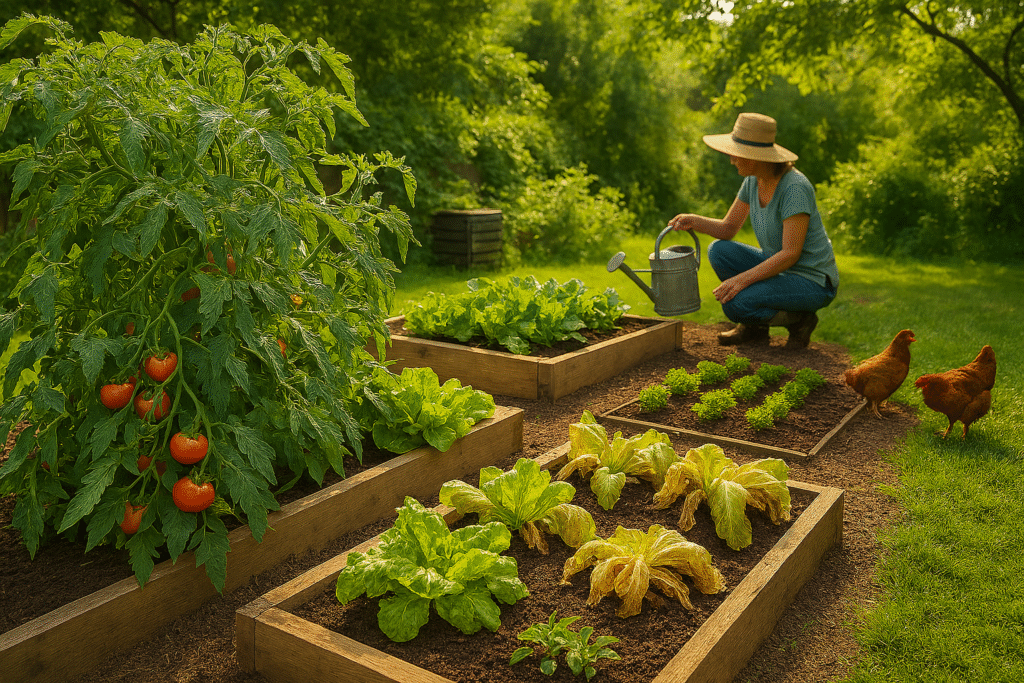Even the most enthusiastic new gardener can run into a few bumps along the way. Learning from these common mistakes will save you time, money, and frustration—helping you grow a thriving garden from day one.

1. Planting Too Much Too Soon
It’s tempting to turn your yard into a mini farm overnight, but starting small is smarter. Overplanting can quickly lead to overcrowded beds, more work than you can handle, and wasted harvests. Begin with a few crops you love to eat, then expand as your skills grow.
2. Ignoring Sunlight Requirements
Every plant has different needs. Sun-loving vegetables like tomatoes, peppers, and squash won’t thrive in shade, while greens like lettuce and spinach prefer partial sunlight. Watch your space throughout the day to understand where and when sunlight hits.
3. Using Poor-Quality Soil
Healthy soil is the foundation of sustainable living gardening. Avoid filling beds with plain dirt from your yard—opt for a high-quality garden soil mix enriched with compost or organic matter for stronger, more productive plants.
When I first started planning my raised beds, I knew that soil quality would make or break my garden. I wasn’t about to fill those beds with whatever dirt I could scrape together from the yard—good garden soil is an investment, and I wanted my plants to have the best start possible.
I headed to my local garden supply store and asked a few questions. The staff was incredibly helpful, walking me through the differences between topsoil, compost, and blended garden mixes. After a little research (and a few handfuls of soil sifted between my fingers), I settled on a rich blend that was about 60% topsoil, 30% organic compost, and 10% perlite for drainage. The compost provided nutrients, the topsoil gave structure, and the perlite kept everything light and airy so roots could spread easily.

They even offered to mix the components on-site, which saved me time and backache. I hauled it home by the truckload, and by the end of the afternoon, my raised beds were filled with dark, crumbly soil that smelled like the start of something good. That blend has been my go-to ever since, and it’s one of the reasons my garden thrives season after season.
4. Overwatering or Underwatering
Finding the right balance of water is one of the most common challenges for beginner gardeners—and one of the biggest factors in plant health. In urban homesteading and sustainable gardening, water efficiency is just as important as plant productivity.
Too much water can suffocate roots by depriving them of oxygen, leading to root rot and fungal diseases. You might notice yellowing leaves, wilting despite moist soil, or a sour smell from the bed. On the other hand, too little water stresses plants, slows their growth, and reduces yields, leaving you with small, tough vegetables or bitter-tasting greens.
How to Get Watering Right:
- Check soil moisture before watering – Insert your finger 2–3 inches into the soil; if it feels dry at that depth, it’s time to water.
- Water deeply, not just often – A slow, thorough soak encourages deep root growth and better drought tolerance.
- Use a drip irrigation system – This delivers water directly to plant roots, reducing waste, preventing foliage diseases, and keeping moisture levels consistent.
- Adjust for the season – Hot summer days require more frequent watering, while cooler months or rainy periods may need less.
By monitoring soil conditions and watering strategically, you’ll create a stable growing environment that supports stronger plants, higher yields, and a more efficient sustainable living garden. Remember: healthy roots mean a healthy harvest.
5. Forgetting About Spacing
Overcrowding plants makes them compete for nutrients, water, and sunlight. Always follow spacing guidelines on seed packets or plant tags. Proper spacing also improves airflow, reducing the risk of disease.
6. Skipping Pest Prevention
Waiting until pests take over is a rookie mistake. Instead, practice proactive pest control with natural solutions like companion planting, neem oil sprays, or beneficial insects.
By avoiding these pitfalls, you’ll set the foundation for a productive and enjoyable urban homesteading experience. Remember—gardening is a journey, and every season offers new opportunities to learn and improve.
